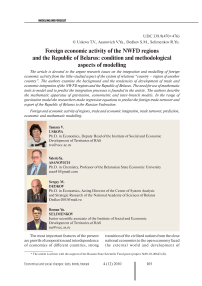Linen textiles - a reserve of economic growth
Автор: Maklakhov Aleksey Vasilyevich
Журнал: Economic and Social Changes: Facts, Trends, Forecast @volnc-esc-en
Рубрика: Branch-wise and regional economy
Статья в выпуске: 4 (12) т.3, 2010 года.
Бесплатный доступ
The paper deals with the possibility to set up production of linen textiles, one of the main products in the domestic light industry. It is proved that to solve this problem it is necessary to strengthen the government support of the linen complex not only at the stage of flax growing but at the following stages of industrial processing - up to turnout of linen products. The author gives a detailed description of a prospective pilot project “Development of the linen complex in Vologda oblast” and its effectiveness.
Light industry, linen products, government support, industry profitability
Короткий адрес: https://sciup.org/147223219
IDR: 147223219 | УДК: 338.4(470.12)
Текст научной статьи Linen textiles - a reserve of economic growth
In the years of market economic reforms, the volume and structure of the domestic consumer market were balanced by solvent demand. The previous concept of deficit, which is understood as mismatch of cash and population’s savings with mass and a range of consumer goods in retail and wholesale trade, is practically disappeared. The share of consumer goods in their total is also changed. Now food product stake front rank for their volume and unit weight, and goods of the light industry take the second place, but they are inferior to provisions a little bit. At the same time the light industry products exceed the market volume of cars, household electronics and other industrial goods.
Thus, in 2009 sales volume of the light industry products amounted to 1,844 billion rubles. It is the double of sales volume of the automobile industry amounted to 900 billion rubles.
In this case the Russian automobile industry receives powerful backing from the budget. In 2009 only the direct budget cost to support the automobile industry was 90 billion rubles.
There were the other measures of direct and indirect stimulation of the industry, including introduction of barrage import duties. At the same time they allocated only 0.55 billion rubles to support the light industry.
The results of analyzing of goods structure on the bases of their production in 2009 are very interesting (fig. 1) .
In Russian automobile market the share of domestic car brands accounted for 31%, foreign cars made in Russia – 18% and the share of imported cars accounted for 51%.
In sales of the light industry goods in the Russian market the share of domestic producers accounted for only 21% and 34% of official import. The remaining 45% were shadow products or smuggled goods. Domestic producers compete with producers of smuggled and bogus goods and they have to reduce their prices to keep their market positions. In this situation their profits are low and as a result tax payments to the state budget are reduced. Annually the production sold by nearly 840 billion rubles becomes untaxable.
Figure 1. Sales structure on the bases of goods production in Russia in 2009, in %
The automobileindustry output
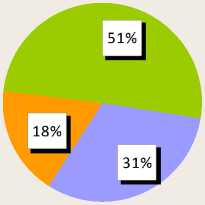
■ Domestic cars
■ Foreign cars made in Russia
■ Imported cars
The light industry output
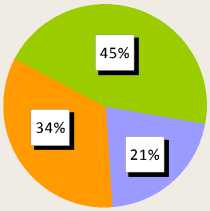
■ Domestic products
■ Official import
■ Illegal import
In the Soviet period the light industry contributed to the budget more than other industrial branches. However, in the 1990’s many light industry enterprises went bankrupt as a result of application of “shock therapy” methods. For 20 years the share of the light industry in Russia’s GDP declined by almost 25 times: from 17% of the total volume in 1990 to 0.7% in 2009. Meanwhile, the share of the light industry in the GDP in the USA is 4%, 6% in Germany, 12% in Italy, 21% in China, 22% in Portugal (fig. 2) .
The textile industry is a very important part of the light industry. It allows different countries to forma significant part of the budget through allocations from the textile industry and the clothing manufacture. Also the textile industry provides the internal market with its own production.
It is clear that the textile industry market in Russia has vast prospects. Currently we let China, Turkey and other foreign producers to occupy this market. It is not reasonable to compete with them for a number of positions, particularly for the cotton products, because this raw material is imported now. However Russia has a great opportunity to increase production of textiles from such a valuable natural fiber as flax.
Flax is a popular brand in Europe. It is an attribute of ecological life. That’s why people
Figure 2. The share of the light industry in GDP of some countries in 2009, in %
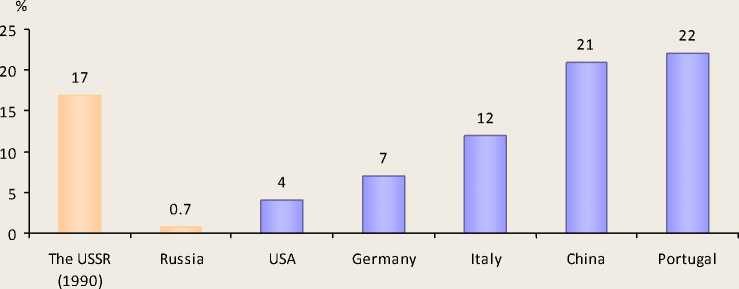
use flax in medicine, clothing, housing construction and decoration. Because of this fact Russia has a good opportunity to export flax products.
In determining the development strategy of the light industry in Russia till 2020 we can see two scenarios for formation of the sales structure of this industry: inertial and innovation (fig. 3) .
If we use the inertial scenario in the light industry, we shall deal to the growth of the share of foreign producers (now it is over 70%) and keep a tendency to increase financial losses of the state, which are already estimated at nearly 45 billion rubles.
Innovation scenario is associated with increasing of the share of domestic production up to 50% and decreasing the share of illegal import and shadow production down to 10%.This scenario is laid out in the document “Strategy for Development of the Light Industry in Russia until 2020”, which was approved by the Order of the Ministry of Industry and Trade from 24.09.2009 № 853.According to this document the retail trade turnover of the light industry will have increased by 1.4 times and it will be 2,833 billion rubles in 2020. Cost of the product made in Russia will be 1.43 trillion rubles. This fact will ensure the income growth of the domestic producers and increase the budget of the Russian Federation.
Persistent development of the linen industry in Russia should playa key role in solving of these problems.
Flax was the main “industrial” plant in Russia for many centuries. It was the main source of funds not only for farmers, but it also replenished the state treasury at the expense of exports. The share of flax in the structure of crops was 6-8% in the regions cultivating flax and it gave up to 70% of cash crop income. At the beginning of the 20thcentury Russia had a half of 1.5 million hectares of the world areas planted under flax and a half of production of 700 thousand tons of flax fiber. Russian treasury annually received up to 90 million golden rubles due to the sale of flax abroad.
There were over 60 major flax factories and 400 plants of the primary processing of flax in Soviet times in Russia. Many of them were cityforming. The population of these cities earned their living at the flax factories and plants. The linen complex was provided with highly skilled specialists, researchers, academics and professional workers. All this facts created the necessary conditions to develop the linen industry.
Figure 3. Structure of sales of the light industry products according to different scenarios in 2020, in %
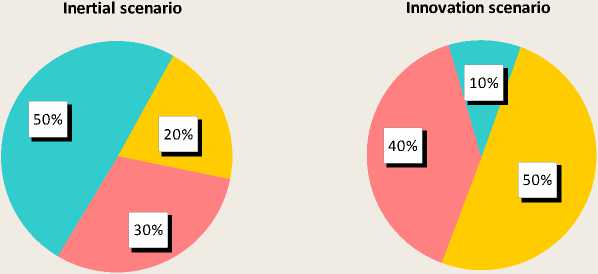
■ Domestic production
■ Official import
■ Illegal import
Unfortunately, the linen complex acquired negative traits during the years of market transformation. Sown areas of flax are systematically cut down and their share in the total area is reduced. At present there are only 14 flax mills in Russia (China has 34 flax mills and 3 flax and cotton enterprises).
About 50% of Russian flax enterprises are unprofitable. The number of registered companies is reduced and active market participants competing in their respective segments are decreased too. The dynamics of companies’ reducing is associated with the major mergers and companies takeover or with low business profitability and its closure due to unequal conditions of competition with shady business. Our analysis shows that if the government doesn’t support the linen industry, from 30 to 50% of existing flax mills will cease their activities.
Vologda oblast is a historic center of flax cultivation. There are the companies here that represent all the major elements of a production chain of flax-containing goods “from the field to a counter”. During several years the region has been solving the problem of the comprehensive modernization of the agricultural and textile segments of the linen complex and removal of imbalance between market demand and business inability to satisfy it. The government of Vologda oblast and Ltd. Company “Dominion” worked out a pilot project “Development of linen complex in Vologda oblast through intersectoral and interterritorial cooperation” to solve these problems.
The region textile sector of the linen complex is currently represented by the public corporation “Vologda textile” in two industrial sites with the full technological cycle (in Vologda and in the town of Krasavino, which is situated in Veliky Ustyug district). Each of the sites specializes in a certain range of products.
To solve the existing problems of the textile sector the pilot project envisages implementation of comprehensive modernization of the basic production, as well as active development of the engineering, transport and storage infrastructure, introduction of the advanced technology by conducting research and development.
Lack of sufficient funds for modernization of all production forces to concentrate the available resources in the key areas; primarily we improve the finishing production to produce fabrics with the finishing touches.
As a result of these measures we have expanded a product range conforming to customer’s demand.34 new sheet of tissue were introduced in 2009. Nowadays they manufactured collection fabrics. The collection is updated twice a year. During the first half of 2010 they developed more than 200 designs of fabrics of various structures and colors. The range of Vologda textile was extended by the foam fabrics, simulating the silver and gold plating. To expand a product range of home textiles they installed a new embroidery machine –the machine with great potential for various kinds of embroidery, cords, ribbons, etc.
In order to reduce the cost of production they developed a project feasibility study for building of a boiler room and a small heat and power plant to produce heat and electricity in the industrial site number 1 of “Vologda textiles”.
There were important measures to expand the sales channels: they opened three offices in Vologda, Ivanovo and Kazan, four own dealership centers in Vologda, St. Petersburg, Ivanovo and Kazan, five retail stores (three stores in St. Petersburg, one store in Vologda and one store in Sochi) in 2009 and for the first half of 2010. In futurethey plan to open two retail stores in the city of Kazan.
The public corporation “Vologda textile” is the only textile enterprise of the Russian Federation, which has received a certificate in accordance with the environmental standard “Eco-Tex” on the whole range of manufactured fabrics.
This certificate confirms that the fabrics of “Vologda textile” meet the highest environmental requirements of the European Union. At present they are going to get the same certificate for the products of home textiles.
If they realize the innovative strategy sequentially, the textile industry in Russia could have a potential to rid the country of import, begin to produce competitive domestic textile, increase its productivity and output, and, therefore, take its deserved place in the domestic and foreign markets.
It is impossible to draw considerable financial resources for investment on a commercial basis because of the low profitability of the project at the early stage and a long payback period. Therefore the government support should serve as a triggering mechanism of the comprehensive modernization of the industry.
At the same time it is necessary to solve the other problems for successful implementation of the pilot project.
-
1. The core ministries (the Ministry of Industry and Trade, the Ministry of Economic Development) should expedite consideration of the mechanisms which can support the pilot projects of development of the light industry in terms of subsidy to 90% of the direct energy costs, transport charges and products’ promotion cost during the investment phase of these projects.
-
2. It is necessary to change an order of interest subsidization on loans intended for replenishment of circulating assets, the technical upgrading and modernization of production by providing subsidies on a regular basis until 2020. It is required to increase the terms of lending and replenishment of circulating assets up to three years, for technical renovation and modernization of production – up ten years.
-
3. The Ministry of Industry and Trade and the Ministry of Finance of the Russian Federation should ensure the replenishment and expansion of the list of imported equipment, which has no domestic analogues and which has no value added tax when it is imported to the territory of Russia, for the light industry based on the requests of the enterprises participating in the pilot projects and conducting modernization.
-
4. It is necessary to promote the useful properties of linen products through the development, organization and conduction of the information and educational programs for population.
All these measures will ensure innovative development and high return on investment; they should improve economic policy and national security and prevent social intensity especially in the places where the city-forming enterprises are located.
Список литературы Linen textiles - a reserve of economic growth
- The Long-term program “Development of the linen complex in Vologda oblast in 2009 -2010”: approved by Governmental regulation of September 9, 2008 № 1719.
- Маklahov, А.V. Cluster approach -the basis of development of the linen complex in the region/А.V. Maklahov//Economic and social changes: facts, trends, forecasts. -2010. -№2. -Pp. 73-81.
- Russian statistical yearbook. 2009: stat. bull./Rosstat. -М., 2009. -795 p.
- Russia in Figures. 2010: short stat. bull./Rosstat. -М., 2010. -558 p.
- Strategy for development of the light industry in Russia until 2020: approved by the Order of the Ministry of Industry and Trade of September 24, 2009 № 853.
- Statistical yearbook of Vologda oblast: stat. bull./Vologdastat. -Vologda, 2009. -407 p.

